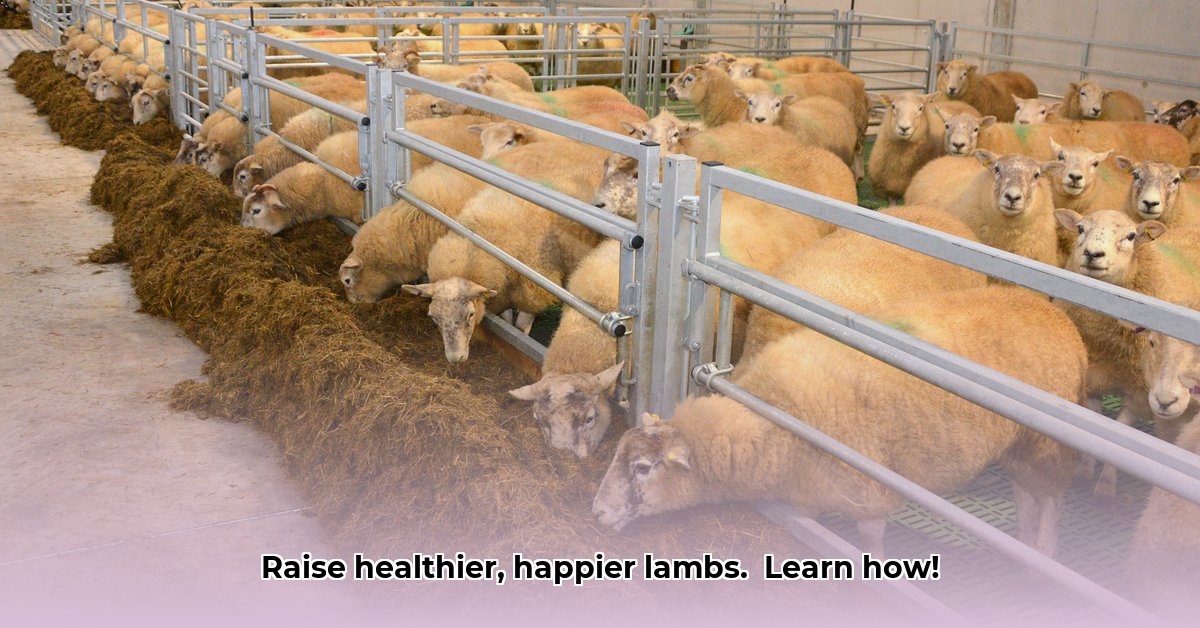
Raising healthy lambs while minimizing your environmental impact is a key goal for modern farmers. This guide will walk you through maximizing the effectiveness of Tractor Supply's lamb feed (and comparable options) to achieve both thriving livestock and sustainable farming practices. We'll cover choosing the right feed, creating a feeding schedule, monitoring your flock's health, and incorporating sustainable methods into your operation. For more information on Tractor Supply products, check out their website here.
Understanding Your Lambs' Nutritional Needs
Lambs, like all livestock, have varying nutritional needs depending on their age and life stage. Newborn lambs require a nutrient-dense diet for rapid growth, while older lambs and breeding ewes need different nutrient profiles to support their development and health. Ignoring these specific needs can lead to stunted growth, health problems, and decreased productivity. Do you know the specific nutritional needs of your lambs based on their current life stage and your local climate?
Tractor Supply offers a range of feeds to cater to these differences. However, if Tractor Supply's selection doesn't perfectly fit your needs, comparable products from other reputable brands can easily be substituted. The key is understanding the nutritional components needed at each stage of growth. For instance, pregnant ewes require a higher energy intake to support fetal development and milk production. Failing to provide this optimal nutrition can lead to weaker lambs and health complications for the ewe.
Choosing the Right Lamb Feed: A Practical Guide
Selecting the optimal lamb feed involves careful consideration of several factors:
Lamb's Age and Life Stage: Newborn lambs need a high-protein, high-energy starter feed to support rapid growth. Growing lambs require a balanced diet to maintain healthy weight gain. Breeding ewes need feeds formulated to support their reproductive cycles and milk production.
Your Budget: Tractor Supply and other retailers offer feeds at varying price points. Balancing cost-effectiveness with nutritional quality is vital for successful and profitable lamb farming. Remember, higher-quality feeds, while more expensive upfront, often lead to healthier lambs and reduced veterinary expenses in the long run.
Sustainability Goals: Incorporating sustainable practices, such as using locally sourced feed and minimizing waste, is becoming increasingly important to many farmers. This not only benefits the environment but also often supports local economies.
Climate: Harsh weather conditions demand adjustments to your feeding strategy. In colder climates, a higher-energy feed might be necessary to prevent weight loss and maintain body temperature. Hot climates may necessitate feeding adjustments to avoid overheating.
Crafting an Effective Feeding Schedule
A well-structured feeding plan is essential for optimal lamb growth and health. Consider these sample schedules (always adapt these to your specific situation and observation of your livestock):
Newborn Lambs (0-3 months): Offer a high-quality starter feed multiple times daily. This frequent feeding is key for rapid growth.
Growing Lambs (3-6 months): Transition to a grower feed, gradually reducing the frequency of feeding. Consistent monitoring of weight gain will be essential to make adjustments as needed.
Breeding Ewes: Pregnant and lactating ewes need a specialized ewe feed to support both their own health and the nutritional needs of their offspring. Ensuring proper nutrition during this period is critical for both the mother's and lambs' wellbeing.
Monitoring Lamb Health: Early Detection is Crucial
Regularly monitoring your lambs' health is paramount. Look for signs of nutritional deficiency or excess:
Dull or Rough Coat: A shiny, soft coat indicates healthy nutrition. A dull or rough coat can suggest a deficiency.
Sluggish Weight Gain: This is a clear indicator that your feeding plan may need adjustments.
Lack of Energy or Lethargy: These symptoms could signal underlying health issues, including nutritional problems.
Early detection of these symptoms allows for prompt adjustments to your feeding strategy and can prevent potentially serious health complications.
Integrating Sustainable Practices
Sustainable farming is an investment in the long-term health of both your animals and the planet. Consider these practices:
Local Sourcing: Purchase feed from regional suppliers to reduce emissions associated with transportation.
Waste Reduction: Proper feed storage and management are essential to prevent spoilage and minimize environmental impact.
Alternative Protein Sources: Explore research into sustainable alternatives, such as insect meal or algae-based proteins, although their widespread adoption is still a matter of ongoing research.
Sample Cost Comparison: Tractor Supply vs. Alternatives
The chart below illustrates a sample cost comparison (Note: Prices and specifications are subject to change. Check local stores for current information).
| Feed Type | Brand | Price (50lb bag) (Example) | Protein (%) (Example) | Energy (kcal/kg) (Example) | Notes |
|---|---|---|---|---|---|
| Lamb Starter | Tractor Supply | $35 | 18 | 3000 | High protein, for rapid growth |
| Lamb Grower | Purina | $40 | 16 | 2800 | Balanced nutrition for continued growth |
| Ewe Feed | Tractor Supply | $45 | 15 | 2600 | Supports pregnancy and lactation |
Key Takeaways & Further Resources
Raising healthy lambs sustainably requires a multifaceted approach. By carefully selecting your feed, developing a sound feeding schedule, diligently monitoring your flock’s health, and integrating sustainable agricultural practices, you'll be well-positioned for long-term success.
[1] American Feed Industry Association (AFIA). Feed: Reducing Animal Agriculture's Environmental Footprint. https://www.afia.org/issues/health-safety-the-environment/sustainability-in-the-animal-food-industry/feed-reducing-animal-agriculture-s-environmental-footprint/